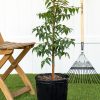Description
So You Haven’t had Luck with Orchids Before? We Can Change That!The Purple Ground Orchids, also known as indoor orchids, are natively found in South Asia and other islands. These flowers bloom for a long time and are the perfect option for indoor plants. These plants typically prefer warm and moist conditions, which is why they are suitable for tropical regions. Caring for your Ground Orchid To grow the Purple Ground Orchid at home, you must ensure that you take good care of it. With the proper care, your Purple Ground Orchid will grow up to be 1 ft. tall and bloom all year. These plants are best to grow in containers; all you need to ensure is that you follow the suitable protocol, and the plant will grow and bloom beautifully.LightThis Purple Ground Orchid likes full sunlight. It would help if you kept it where the plant could get full exposure. However, it is best if the sunlight is not direct. You can give the plant 6 hours of indirect sunlight every day. If it does not receive enough sunlight, it will stunt the plant growth, and the flowers will not bloom properly.SoilSince the plant is an epiphyte usually grown on big trees in tropical forests, plant owners need to mimic the environment. You can add coconut shells, wood chips, and water moss to the soil for its growth. You can add perlite as the soil substrate and get a well-draining soil designed exclusively for orchids.WaterThese orchids are drought-tolerant but bloom exceptionally well when given adequate water. The growing season is summer, and it is best to water the plant once per week. Come fall, you can reduce watering the plant to 10 days at a time. You can make sure that the air is moist using a mist. Also, keep an eye on the pH level of water; the plant prefers neutral water.FertilizerFor the indoor orchids to grow and bloom, you do not need to give them a lot of fertilizer. You can go for a nitrogen-rich fertilizer once in 10 days. This will help with sprouting. During summer, you can use a more balanced fertilizer to prepare your plant to bloom in the fall.Common IssuesOn the whole, the Purple Ground Orchid is an easy plant to grow and does not face a great many problems. However, you must look out for the following common issues. PestsMultiple pests may damage your plant. For instance, Spider mites may feed on the sap of the leaves, or they can be scale insects. Insects will hinder the growth of your plant. You must spray pesticides on your plants immediately and get rid of the insects. Snail and slugs are also very commonly found on the Purple Ground Orchid. DiseaseDiseases like Anthracnose and Gray Mold are prevalent in the Spathoglottis plicata. Anthracnose and Gray Mold are fungal diseases and can affect your plant during the summer. You will find circular brown spots on the leaves to spot the diseases. You must immediately remove the affected parts and spray a fungicide to get rid of the diseases. Other diseases include Southern Blight, Cercospora Blight, and Scotty mold.PruningIf you wish to prune the Spathoglottis plicata, you must do it when the flowers have wilted. This will help stop the plant from consuming nutrients that other parts of the plant can use. Pruning wilted flowers will promote the blooming of different flowers. You can also trim the withered leaves and improve the air circulation. Pruning will also help prevent the infestation of insects and diseases. PropagationYou can propagate the Purple Ground Orchid in two ways; you can either propagate it using divisions or with the help of cuttings. To propagate with divisions, you can divide the plant first and take it out with the roots intact. You can then cut through the roots and divide them into multiple portions. You can then plant the roots into different containers; make sure to spray them with plenty of water to grow properly. If you propagate using cuttings, be sure to use thick and healthy stems and cut them into multiple pieces, and then put them into the substrate. Potting / RepottingThere is no need to use a large pot for your Purple Ground Orchid. You can quickly grow it in containers as they do not take up a lot of space. You do not need to re-pot it multiple times as the plant does not grow too big.





